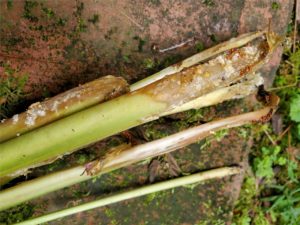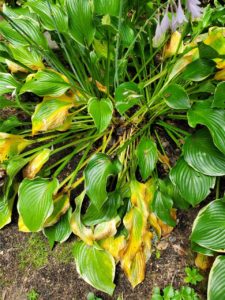Pest Alert: Southern Blight on Perennials
go.ncsu.edu/readext?724164
en Español / em Português
El inglés es el idioma de control de esta página. En la medida en que haya algún conflicto entre la traducción al inglés y la traducción, el inglés prevalece.
Al hacer clic en el enlace de traducción se activa un servicio de traducción gratuito para convertir la página al español. Al igual que con cualquier traducción por Internet, la conversión no es sensible al contexto y puede que no traduzca el texto en su significado original. NC State Extension no garantiza la exactitud del texto traducido. Por favor, tenga en cuenta que algunas aplicaciones y/o servicios pueden no funcionar como se espera cuando se traducen.
Português
Inglês é o idioma de controle desta página. Na medida que haja algum conflito entre o texto original em Inglês e a tradução, o Inglês prevalece.
Ao clicar no link de tradução, um serviço gratuito de tradução será ativado para converter a página para o Português. Como em qualquer tradução pela internet, a conversão não é sensivel ao contexto e pode não ocorrer a tradução para o significado orginal. O serviço de Extensão da Carolina do Norte (NC State Extension) não garante a exatidão do texto traduzido. Por favor, observe que algumas funções ou serviços podem não funcionar como esperado após a tradução.
English
English is the controlling language of this page. To the extent there is any conflict between the English text and the translation, English controls.
Clicking on the translation link activates a free translation service to convert the page to Spanish. As with any Internet translation, the conversion is not context-sensitive and may not translate the text to its original meaning. NC State Extension does not guarantee the accuracy of the translated text. Please note that some applications and/or services may not function as expected when translated.
Collapse ▲Southern blight is caused by the fungus Sclerotium rolfsii, which lives in soil, on plants (including weeds), plant debris and mulch. The fungus can be spread through movement of infested soil, plants, or mulch. Excessive soil moisture can lead to serious infestations in perennial ground cover plantings as well as shrubs and flowers.

Southern blight causes stems to rot at ground level. Round structures called sclerotia form and are diagnostic.
The fungus causes a rot at the base of the plant. Plants turn brown and die. The fungus forms little round structures called sclerotia and the presence of these survival structures is diagnostic.
Infested soil must be removed. Look for the edges of the infestation based on visible dead/dying plants, fungal material, and sclerotia. Remove all of the affected plants and roots. Be sure to dig up at least three inches of the topsoil, from at least 12 inches beyond the area of diseased plants. Dispose of plants and soil in the trash.
Any new plants and other plants surrounding the infested plants should be treated with fungicides. The NC State Extension Pesticide Handbook says the following products are the best for control (highlighted ones likely easiest to find):
- Daconil
- Heritage
- Revere
- Terraclor
- Pageant
- Cleary
- Trinity





